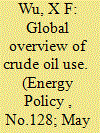|
|
|
Sort Order |
|
|
|
Items / Page
|
|
|
|
|
|
|
| Srl | Item |
| 1 |
ID:
166344


|
|
|
|
|
| Summary/Abstract |
This paper conducts a systems input-output analysis to form an overview of crude oil use in the globalized world economy in 2015. The use of crude oil is tracked from the sources of exploitation to the sinks of final use through the channels of inter-regional trade. This paper finds that the top five oil users, the United States, Mainland China, Japan, South Korea and Canada, are together responsible for half of global oil use. The global volume of oil embodied in trade is twenty percent larger than that in oil exploitation, and the role of the trade of non-oil goods in the global oil balance is comparable to that of the direct oil trade. The United States is the biggest net importer of oil use, in contrast to Mainland China, which is the biggest net importer of direct oil. In order to characterize a region's energy security, new indices for its dependence on external sources of oil are devised. The inter-regional transfer of the environmental burden associated with oil use, leading to the dilemma of “regional decrease at the expense of global increase”, is shown to be inherent to existing energy strategies.
|
|
|
|
|
|
|
|
|
|
|
|
|
|
|
|
| 2 |
ID:
162892


|
|
|
|
|
| Summary/Abstract |
As the world is smoothing the transition towards a low-carbon energy structure, natural gas has occupied a critical position in global energy supply. Also, globalization has catalyzed ever-increasing indirect energy flows in international trade. In order to present a comprehensive overview of natural gas use in globalized economy, this paper applies the systems multi-regional input-output (MRIO) analysis to track natural gas use from primary suppliers to final consumers via the links by producers in the world economy, supported by typical statistics for the year of 2011. Natural gas embodied in international trade is revealed amounting to 2722.1 bcm, in magnitude up to 90% of total gas extraction for energy use, indicating the intensive relocation of gas use by trade. 83% of traded embodied natural gas is associated with intermediate trade, mainly from leading primary suppliers, including Russia, USA and Western Asia, to dominant final consumers, like USA, EU27 and East Asia. Significant differences are found between direct and embodied natural gas flows. Consumption-based resource efficiency can break the illusion of efficiency improvements, and trade imbalance in terms of gas use can be opposite to the trade imbalance in conventional monetary terms. This paper has constructed a comprehensive analytical framework to trace natural gas flows in globalized economy for the first time, aiming to provide new insights for policy making.
|
|
|
|
|
|
|
|
|
|
|
|
|
|
|
|
|
|
|
|
|